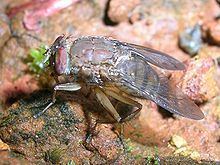Subfamily Calliphorinae Scientific name Bengalia Higher classification Blow flies Order Fly | Tribe Bengaliini Rank Genus | |
 | ||
Similar Blow flies, Fly, Insect, Polleniinae, Stomorhina | ||
Bengalia is a genus of blow flies in the family Calliphoridae with one authority considering the genus to belong to a separate family Bengaliidae. These bristly and, unlike the greens and blues of most calliphorids, dull coloured flies, are especially noted for their relationship to ants. Little is known of their biology and life-cycle, although adults of many species are kleptoparasitic on ants and will snatch food and pupae being carried by ants or feed on winged termites.
Contents
Description
Most of the species have a yellow or brown ground-colour, an antero-posteriorly compressed head, stout mouthparts, a projecting clypeus below the lower facial margin and have a silent flight. Very little is known about their breeding habits. The genus is found in the Afrotropical and oriental region with one species from Australia possibly a recent introduction.
The group (placed at family rank by Lehrer (2005)), has the following morphological characters:
Species
The following is a partial list of species in the genus:
Taxonomic dispute
The genus was reclassified into 11 new genera in 4 subfamilies by Andy Lehrer in 2005, within a newly designated family, Bengaliidae. The family designation was disputed by Rognes (2006) who noted that it was equivalent to the already established tribe Bengaliini, and that treating it as a family renders the Calliphoridae paraphyletic. Further Rognes considers all the new genera created as junior names for Bengalia. Lehrer's work adds 49 species to the already described 41 species and 18 of these new species are treated as invalid by Rognes. At present, major sources of Dipteran taxonomy do not recognize Lehrer's 10 new genera as valid, nor the 18 new species treated as invalid by Rognes (e.g. ).
This dispute reflects that at present, there is no consensus as to the best way to subdivide the Calliphoridae, which many authorities acknowledge is not a natural group (in this case, polyphyletic); the BioSystematic Database of World Diptera, for example, states "The Calliphoridae are marked as a polyphyletic group of convenience as at the present we are unwilling to reduce the Oestridae to a subordinated group within a monophyletic Calliphoridae nor to elevate a number of other groups (Polleniidae, Helicoboscidae, and Bengaliidae) so as to properly delimit both Calliphoridae and Oestridae."[5] Similarly, the dispute at the generic level is that some of Lehrer's genera are paraphyletic, and, additionally, that they are based largely or exclusively upon features of the male genitalia, and it is therefore impossible to identify most female specimens to subfamily, let alone genus (the rejection of Lehrer's subdivisions therefore being both taxonomic and a matter of practicality). The dispute at the species level centers on the fact that Lehrer did not include or examine 24 of the 41 known species in his revision, so of the 31 species he validly described that were not immediately synonymized, many could still potentially be synonyms of these 24 excluded species.
